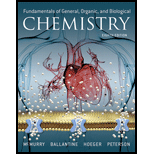
(a)
Interpretation:
The moles of
Concept Introduction:
Ideal gas Equation:
Any gas can be described by using four terms namely pressure, volume, temperature and the amount of gas. It is referred as ideal gas equation.
Under some conditions gases don not behave like ideal gas that is they deviate from their ideal gas properties. At lower temperature and at high pressures the gas tends to deviate and behave like real gases.
Moles: One mole is equivalent to the mass of the substance consists of same number of units equal to the atoms present in
(b)
Interpretation:
The
Concept Introduction:
It is defined as the negative base-10 logarithm of the hydrogen or hydronium ion concentration.
If the value of
Molarity: The concentration for solutions is expressed in terms of molarity as follows,
Strong Acids: Acids that dissociates into ions completely which results in easy donation of protons are considered as strong acids. Strong acid forms weaker conjugated base.
Want to see the full answer?
Check out a sample textbook solution
Chapter 10 Solutions
FUND.OF GENERAL,ORG.+BIO.CHEM.(LL)-PKG
- What are the molarity and the normality of a solution made by dissolving 25 g of citric acid (triprotic, C6H5O7H3) in enough water to make 800 mL of solution?arrow_forwardHow many grams is one mole of potassium chloride KCI?arrow_forwardIn order to make a solution of the concentration 0.364 M, what mass of NaCl should bedissolved in 152 mL of water?arrow_forward
- How many grams of glucose (C6H2O6 molecular mass =180daltons) would be present in one liter of a 1M (molar) solution of glucose?arrow_forwardWhat is the molarity of a solution that contains 50.0 g of vitamin B1 hydrochloride (molar mass = 337 g/mol) in 160 mL of solution?arrow_forwardPropanamide and methyl acetate have about the same molar mass, both are quite soluble in water, and yet the boiling point of propanamide is 486 K, whereas that of methyl acetate is 330 K. Explain.arrow_forward
- What is the mass in grams of 24.2 moles of NaCl?arrow_forwardHow many moles of ions are in 1.75 mol of K2SO4?arrow_forwardYour patient drank the following liquids for breakfast: 220 ml of orange juice, 180 ml of milk and 150 ml of coffee. How many milliliters of liquid did your patient drinkarrow_forward

